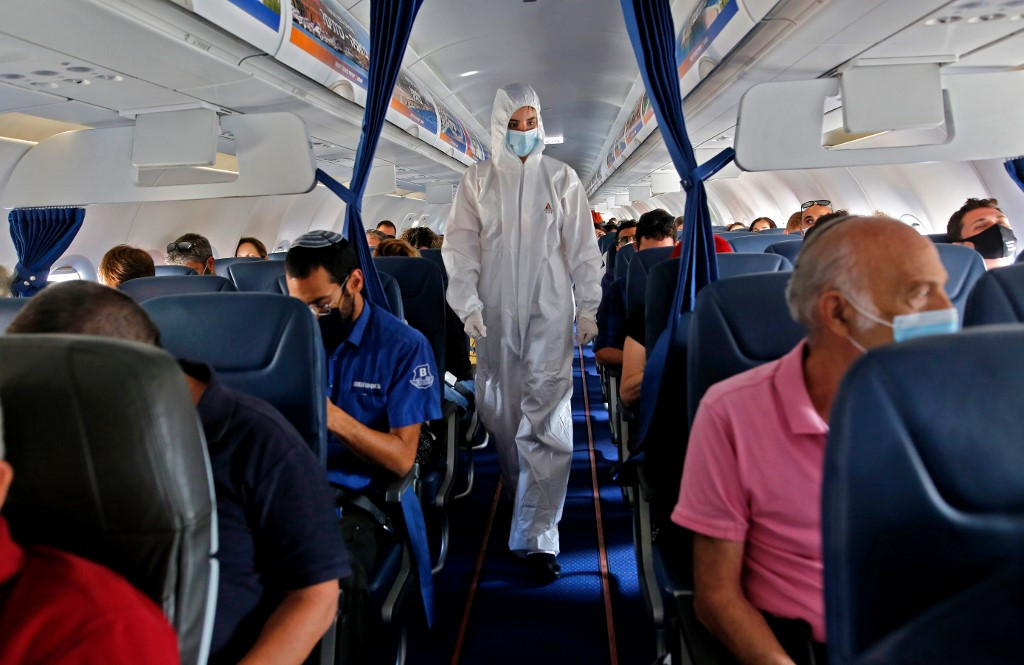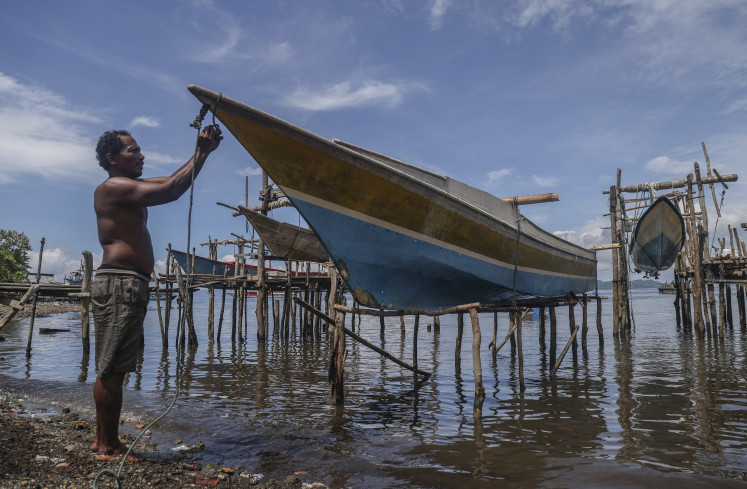Popular Reads
Top Results
Can't find what you're looking for?
View all search resultsPopular Reads
Top Results
Can't find what you're looking for?
View all search resultsAirlines in the middle of coronavirus storm
Understandably, the travel restrictions and the strict health protocols such as physical distancing, compulsory wearing of masks, health certificates and additional time needed for all the checks for air passengers have caused most people to avoid traveling by air. This in turn has slashed airline revenues and put them in severe liquidity crises.
Change text size
Gift Premium Articles
to Anyone
 A stewardess of Israir Airlines wearing full PPE (personal protective equipment) prepares for take off from the Ben Gurion International Airport near the central Israeli city of Tel Aviv to southern Israeli Red Sea resort city of Eilat amid the COVID-19 pandemic, on June 16, 2020. (AFP/GIL COHEN-MAGEN )
A stewardess of Israir Airlines wearing full PPE (personal protective equipment) prepares for take off from the Ben Gurion International Airport near the central Israeli city of Tel Aviv to southern Israeli Red Sea resort city of Eilat amid the COVID-19 pandemic, on June 16, 2020. (AFP/GIL COHEN-MAGEN )
O
ne of the industries hardest hit by the COVID-19 pandemic is civil aviation. The global health crisis has forced airline companies to ground their planes and lay off workers. Many are even on the verge of bankruptcy due to severe travel restrictions, if not given government bailouts.
Understandably, the travel restrictions and the strict health protocols such as physical distancing, compulsory wearing of masks, health certificates and additional time needed for all the checks for air passengers have caused most people to avoid traveling by air. This in turn has slashed airline revenues and put them in severe liquidity crises.
Physical-distancing rules require airlines to initially limit seat capacity to 50 percent. Even though the Transportation Ministry has eased restrictions to 70 percent seat capacity and lengthened the validity of health certificates from three days to two weeks, airline cash flows continue to suffer.
Read also: Garuda turns in first-half losses as pandemic hits aviation
On the other hand, air freight services have not been adversely affected. Instead they have tended to increase on several routes across the vast archipelago. This cargo service could help airlines to survive the pandemic.
The volume of air passengers that nosedived 80 percent two months ago has slightly increased and the number of flights has crept up from 20 percent to 40 percent, compared with the 2019 figure. But since not all service routes have been reopened, it will be difficult for airline companies to push the number of passengers further up.
The flow of take-offs and landings at Jakarta’s international airport of Soekarno-Hatta last month averaged 300 to 350 daily, far below the 1,100 daily in 2019.
Many analysts have predicted that air travel will continue to be weak until 2025, as people remain hesitant to travel by air. The International Air Transport Association (IATA) said that global flights would recover by 2023. This estimate is widely seen by various parties as too optimistic, but in general, the results of expert studies have indeed showed that it will take three to five years for the airline industry to recover to 2019 levels.
For Indonesia, the world’s largest archipelagic country, the recovery may come sooner than the prediction above. Barring any steep rise in new infections nationwide, the Transportation Ministry may again ease the 70 percent seat capacity restriction in the near future.
As the volume of air freight services has been much bigger than passenger services since the coronavirus outbreak, the government may need to adjust the regulations on cargo services to help the airline offset the steep drop in their passenger services, thereby preventing them from going bankrupt.
Read also: State injects Rp 881 billion into airport operator Angkasa Pura II
It may be necessary for the government to allow cargo planes to also carry passengers on certain routes.
Certainly, such mixed services require some adjustments in flight operating procedures related to the layout of goods and people in the cabin. The point is that there must still be a variety of possible ways to help the airlines to survive until the pandemic ends.
The question now is when the airline crisis will end. Most analysts predict that in so far as no vaccine and medical treatment for COVID-19 has been available in the market, human interaction will always be seen as dangerous due to the high risk of infection.
And as long as human interaction is still perceived to be dangerous, people will continue to refrain from air travel. With most medical experts predicting that a vaccine for the coronavirus may be available in the first half of next year, the airline industry will only start its recovery after that.
***
Chappy Hakim, a former Indonesian Air Force chief, is chairman of Indonesia Center for Air Power Studies, where Tommy Tamtomo is research and development director.









